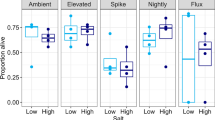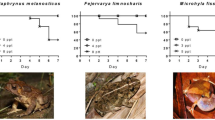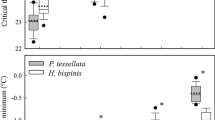Abstract
The temperature regime of the intertidal microhabitat of two species of co-existing amphibious stichaeoid fishes, Anoplarchus purpurescens and Pholis ornata, were compared with experimentally determined tolerances to elevated temperatures. Studies of the critical thermal maxima of the two species revealed only slight differences in temperature tolerance but exposure to a cycled pattern of high temperatures sharply differentiated the resistance times of the two species with P. ornata capable of tolerating greater cumulative exposure to thermal stress when administered in a cycled program of temperature fluctuations with peak temperature at 27 °C. While the experimentally determined temperature tolerances exceeded those measured in the field, the greater tolerance of P. ornata may facilitate habitation of intertidal mudflats during summer months.
Similar content being viewed by others
References
Barton, M. G., 1978. Influence of temperature and salinity on the adaptation of Anoplarchus purpurescens and Pholis ornata to an intertidal habitat. Ph. D. Thesis, Oregon State Univ., Corvallis, 105 pp.
Barton, M. G., 1982. Comparative distribution and habitat preferences of two species of stichaeoid fishes in Yaquina Bay, Oregon. J. exp. mar. Biol. Ecol. 59: 77–87.
Bayer, R. D., 1980. Shallow water intertidal ichthyofauna of the Yaquina Estuary, Oregon. Northwest Sci. 55: 182–193.
Brown, J. H. & C. R. Feldmeth, 1971. Evolution in constant and fluctuating environments: thermal tolerances of desert pupfish (Cyprinodon). Evol. 25: 390–398.
Dehart, D. A., 1974. Resistance of three freshwater fishes to fluctuating thermal environments. MS Thesis. Oregon State Univ., Corvallis. 82 p.
Duman, J. G. & A. L. DeVries, 1974. The effects of temperature and photoperiod on antifreeze production in cold water fishes. J. Exp. Zool. 190: 89–98.
Feldmeth, C. R., E. A. Stone & J. H. Brown, 1974. An increased scope for thermal tolerance upon acclimating pupfish (Cyprinodon) to cycling temperatures. J. Comp. Physiol. 89: 39–44.
Fry, F. E. J., 1967. Responses of Vertebrate poikilotherms to temperature. In: A. H. Rose (ed.), Thermobiology. Acad. Press, N.Y.: 375–409.
Gonor, J. J., 1970. Oregon coastal marine animals, their environmental temperatures and man's impact. I n Man and Aquatic Communities, Semin. conducted by Wat. Resour. Res. Inst., Oregon State Univ., Limn.: 79–102.
Grossman, G. D., 1982. Dynamics and organization of a rocky intertidal fish assemblage: the persistence and resilience of taxocene structure. Am. Nat, 119: 611–637.
Heath, W. G., 1967. Ecological significance of temperature tolerance in Gulf of California shore fishes. J. Ariz. Acad. Sci. 4: 172–178.
Nakamura, R., 1976a. Temperature and vertical distribution of two tidepool fishes (Oligocottus maculosus, O. snyderi). Copeia 1976(1): 143–151.
Nakamura, R., 1976b. Experimental assessment of factors influencing microhabitat selection by the two tidepool fishes Oligocottus maculosus and O. snyderi. Mar. Biol. 37: 97–104.
Otto, R. G., 1974. The effects of acclimation to cyclic thermal regimes on heat tolerance of the western mosquitofish. Trans. Am. Fish. Soc. 103: 331–335.
Paladino, F. V., J. R. Spotila, J. P. Schubauer & K. T. Kowalski, 1980. The critical thermal maximum: a technique used to elucidate physiological stress and adaptation in fishes. Rev. Can. Biol. 39(2): 115–122.
Pearcy, W. C. & S. S. Myers, 1974. Larval fishes of Yaquina Bay, Oregon: A nursey ground for marine fishes. Fish. Bull. 72: 201–213.
Schrode, J. B., K. E. Zerba & J. S. Stephens, Jr., 1982. Ecological significance of temperature tolerance and preference of some inshore California fishes. Trans. Am. Fish. Soc. III: 45–51.
Thompson, D. A. & C. E. Lehner, 1976. Resilience of a rocky intertidal fish community in a physically unstable environment. J. exp. mar. Biol. Ecol. 22: 1–29.
Vondracek, B., J. J. Cech, J. Longanecker & D. Longanecker, 1982. Effect of cycling and constant temperature on the respiratory metabolism of the Tahoe sucker, Catostomus tahoensis (Pisces: Catostomidae). Comp. Biochem. Physiol. 73A: 11–14.
Wolcott, T. G., 1973. Physiological ecology and intertidal zonation in limpets. (Acmaea): a critical look at ‘limiting factors’. Biol. Bull. 145: 389–422.
Author information
Authors and Affiliations
Rights and permissions
About this article
Cite this article
Barton, M. Response of two species of amphibious stichaeoid fishes to temperature fluctuations in an intertidal habitat. Hydrobiologia 120, 151–157 (1985). https://doi.org/10.1007/BF00032136
Received:
Revised:
Accepted:
Issue Date:
DOI: https://doi.org/10.1007/BF00032136




